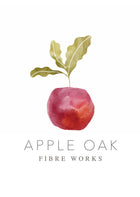

Black Walnut Shells
Dye Colour: Earthy Light and Dark Browns | Cultivated in the USA
Using Black Walnut Shells for dyeing results in a rich, natural-looking earthy brown colour after one or two dye baths for deeper tones. This dye works especially well with silk and wool materials and is known for its excellent colour fastness.
Black Walnut (Juglans nigra) is a native North American tree known for its strong wood and high tannin content, which is ideal for natural dyeing. The shells are a rich source of tannins, giving the dye its deep, earthy brown hues. Traditionally, Black Walnut has been used for both dyeing and in herbal medicine.
Colour Fastness: Excellent
Colour Outcomes by WOF Ratio:
Basic Recipe for Earthy Brown:
Instructions:
Unlock the rich, earthy tones of Black Walnut Shells and enjoy the depth and warmth it brings to your fabrics and yarns. Perfect for eco-conscious makers and those looking for natural, long-lasting colours.
Join The Natural Dyers & Growers Academy to share your experiences and get support from fellow growers.
Catechu Dye – Dye Colour: Brown and Beige | Botanical: Acacia catechu | Produced & Processed in India
Catechu, also known as Cutch, is a versatile natural dye that produces a beautiful range of brown and beige shades on cotton, silk, and wool fibres. This dye is composed of two components: catechu-tannic acid, which dissolves in cold water, and catechin, which requires hot water for extraction. Catechu is rich in tannins and will dye without the need for a mordant, though it can also benefit from one for brighter results. Some even suggest Catechu may help those with eczema – an added bonus for a naturally healing dye!
Colour Fastness: Good
Product Details:
Basic Recipe:
Note:
Enjoy the versatility of Catechu dye and explore its potential for a wide range of beautiful brown and beige hues in your projects!
Join The Natural Dyers & Growers Academy to share your experiences and get support from fellow growers.
OAK BARK DYE (Quercus spp.)
Dye Colour: Golden Beige and Browns | Country of Collection: Poland
Oak Bark is a tannin-rich, natural dye source used for centuries to achieve warm, earthy tones on wool and silk. Thanks to its high tannin content, no mordant is strictly necessary, but will result in better colour fastness. Experimenting with iron and adding oak galls can deepen or modify your results. Lighter beige tones emerge with lower pH (around 5), and deeper browns develop under higher pH (around 8), though iron is a more stable solution for darker tones.
Colour Fastness: Good
Ingredients:
Instructions:
Embrace the rich tradition of oak bark dye and bring timeless, organic hues to your fibre projects—perfect for both beginners and seasoned natural dyers.
Join The Natural Dyers & Growers Academy to share your experiences, join courses and get support from fellow growers and dyers.
OAK MOSS ~ Dye colour Champange Beige to Brown
*Oak Moss from responsibly harvested forests in Mazedonia.
Champagne is the closest colour I can think of to describe the colour obtained by Oak Moss. You can influence the nuances by adding different mordants, but generally no mordant is necessary.
Oak Moss is also used for Soap making to add texture and scrub to the soap.
Colourfastness: good
From Wikipedia
Evernia prunastri, also known as Oak Moss, is a species of lichen. It can be found in many mountainous temperate forests throughout the Northern Hemisphere, including parts of France, Portugal, Spain, North America, and much of Central Europe. Oak moss grows primarily on the trunk and branches of oak trees, but is also commonly found on the bark of other deciduous trees and conifers such as fir and pine. The thalli of oak moss are short (3–4 cm in length) and bushy, and grow together on bark to form large clumps. Oak moss thallus is flat and strap-like. They are also highly branched, resembling the form of deer antlers. The colour of oak moss ranges from green to a greenish-white when dry, and dark olive-green to yellow-green when wet. The texture of the thalli are rough when dry and rubbery when wet. It is used extensively in modern perfumery.
-------------------------------
A basic Recipe:
50% oak moss or more
wool/yarn ~ no mordant needed
Simmer moss for 3 hours.
Strain through Cloth.
Add wet wool to the dye pot.
Let it simmer for 1h, cool and leave overnight.
Rinse and dry.
Join The Natural Dyers & Growers Academy to share your experiences and get support from fellow growers.
Dried Organic Walnut Shells
Rich Golden & Dark Browns for Dyeing | Wild-Harvested in Croatia
Walnut shells are a natural dye source, producing beautiful golden to deep brown hues. While fresh green husks yield the richest browns, dried shells provide an accessible and effective alternative—perfect for wool and silk dyeing.
Colour Fastness: Good – Excellent
(Adjust quantities as needed for different shades.)
A sustainable and traditional way to achieve rich, earthy browns in your fibre projects!
We’re not fans of crowded inboxes either, so here’s what you can look forward to in our newsletters:
✨ Updates from the Academy – new workshops, courses, and events
🧶 News from the Dye House – behind-the-scenes, fibre stories, and inspiration
🛍 Shop highlights – fresh arrivals, special offers, and exclusive sales
And of course, you’re always in control — unsubscribe anytime with a single click at the bottom of any email.
As a little welcome gift, enjoy 5% off your first order in our webshop with the code WELCOMEPOP.
Happy making! 🌿








